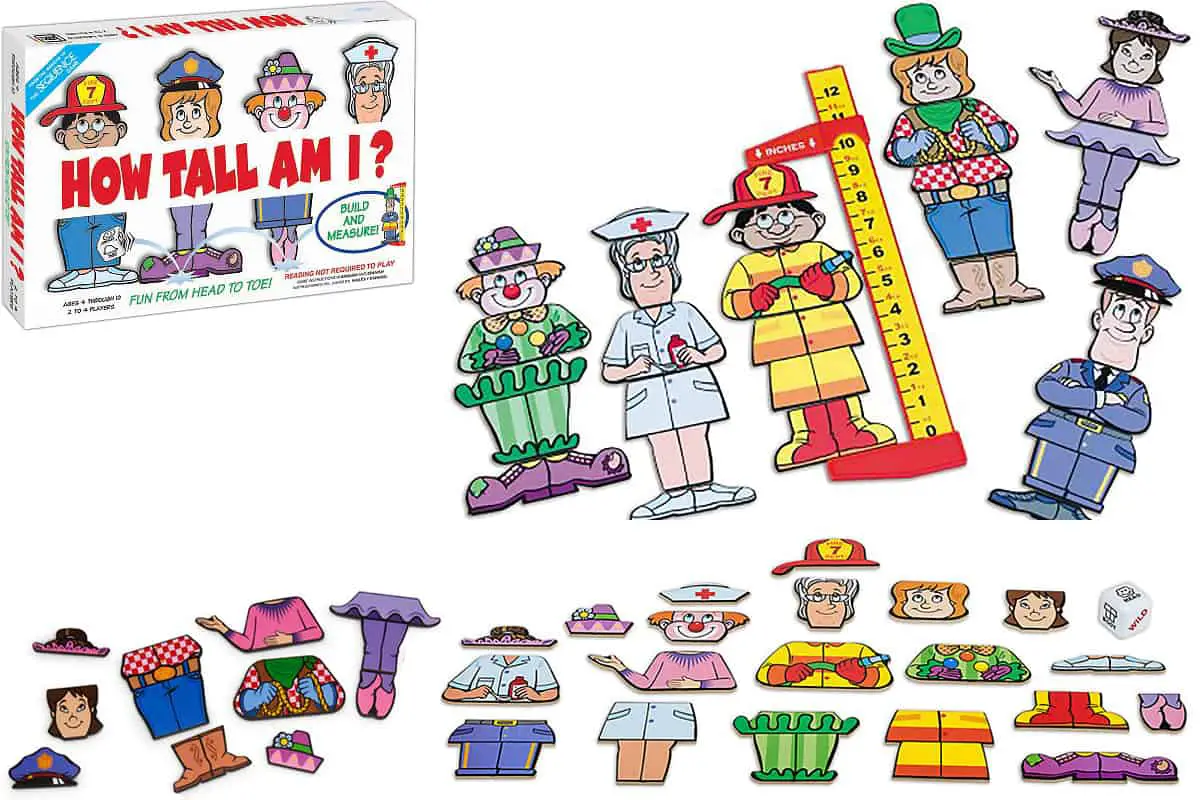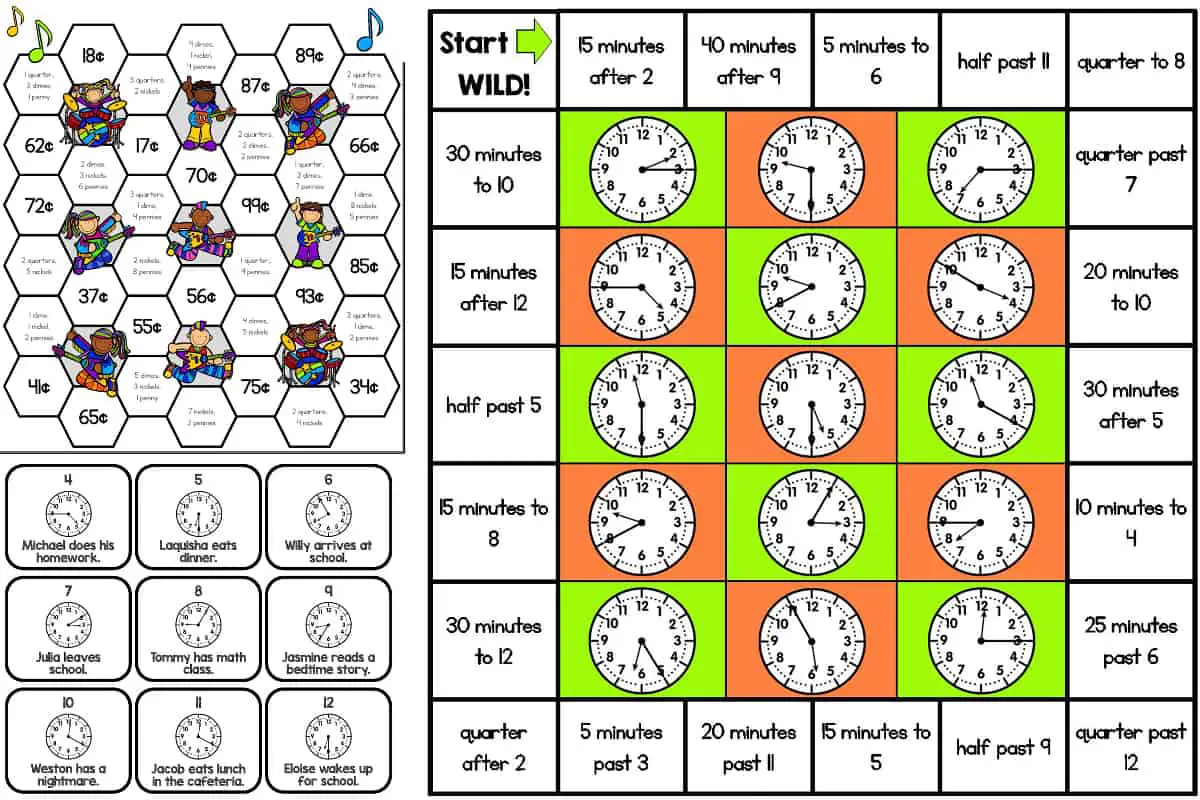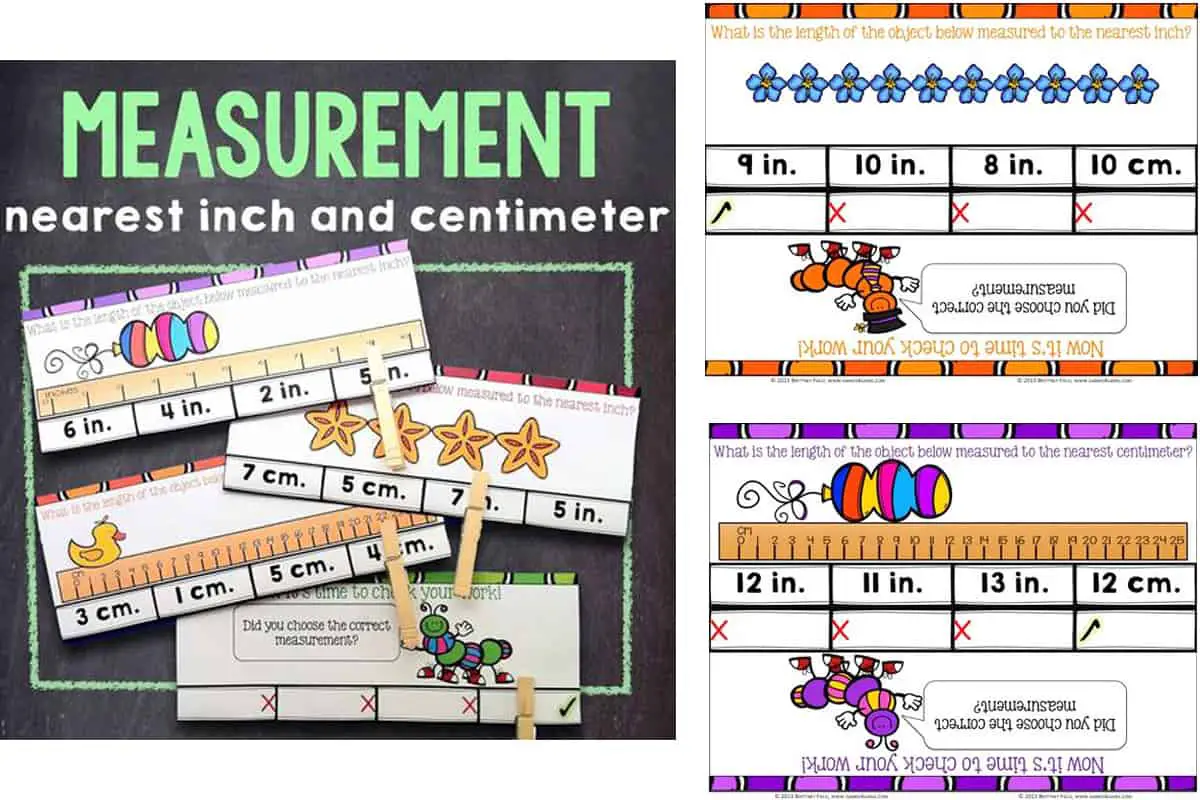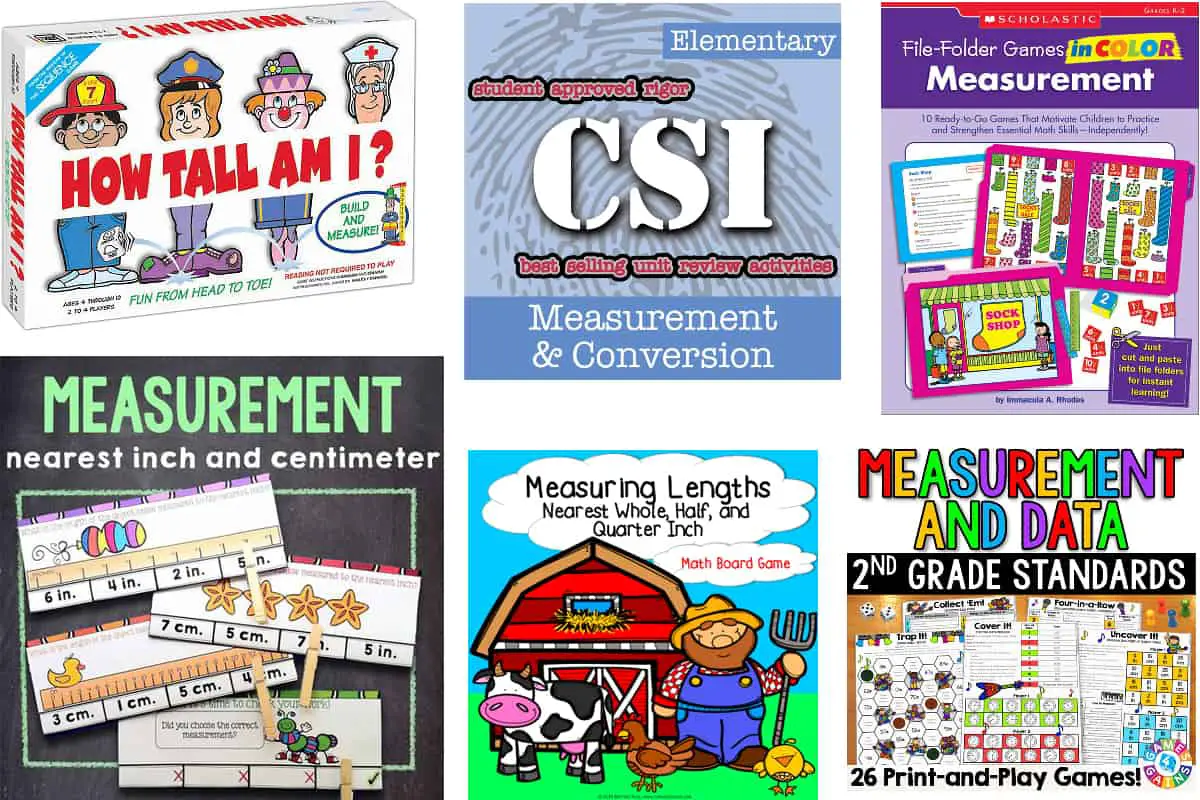This post contains affiliate links.
Metric conversion is one of the most real-life topics in math. You can use games to improve the learning experience and the memorization of these conversions.
I found six board and card games for converting metric units for ages 3 to 10. I recommend “Crime Scene” and “Measurement,” which are really rich in content.
Unit Related Games Comparison Table
| Game | Age | Notion worked | Players | Price | Target |
| How Tall Am I? | 3-6 | Measuring length | 2-4 | $$ | Families |
| Measurement | 4-8 | Measuring length, area, weight, volume, temperature.. | 2-4 | $$ | Teachers |
| Measurement and Data Games | 7-8 | Telling time, interpreting graphs, counting money, measuring lengths | 2 | $ | Teachers |
| Measurement “clip and flip” cards | 7-8 | Estimating lengths | 2 | $ | Teachers, Families |
| Measuring Lengths | 8-9 | Measuring length | 2 | $ | Teachers, Families |
| Crime Scene | 8-10 | Converting and Comparing Units, Metric and Customary Units and Time. | 2 | $ | Teachers |
Unit Measuring and Converting Games for Primary School
How Tall Am I? (Jax Games)

Players: 2-4 | Ages: 3-8 | CCSS Grade: PreK – Grade 2 | Price $$
How Tall Am I puts an interesting twist on learning how to measure length. It has 30 character parts, a custom measuring ruler, and a die. The aim is to be the player to create the longest character. The process of creating the longest character is what makes this game fun and engaging.
puts an interesting twist on learning how to measure length. It has 30 character parts, a custom measuring ruler, and a die. The aim is to be the player to create the longest character. The process of creating the longest character is what makes this game fun and engaging.
The customized die has images instead of the dots you would see on a traditional die. The images represent parts of characters (hat, head, arms, body, and feet). Each player rolls the die and selects the corresponding character piece. If the player already has that character piece, he or she loses the turn.
When each player has successfully created a character, it is measuring time! Each player uses the provided ruler to measure the characters. The player with the tallest character wins!
The simplicity of this game makes it perfect for young children. There is no progression in difficulty, though, meaning that you will not use it many times.
Measurement (Scholastic)

Players: 2-4 | Ages: 3-8 | CCSS Grade: PreK – Grade 2 | Price $$ | Author: Immacula Rhodes
Scholastic is famous for its ready-to-use file-folders. This 1-pound file folder game in color contains 144 pages spanning ten engaging games to learn to:
contains 144 pages spanning ten engaging games to learn to:
- Practice measuring with nonstandard units
- Measure in inches & centimeters
- Use a scale to measure distances
- Find an area using a grid
- Compare weights
- Use liquid measurement
- Identify kitchen units of measurement
- Read a thermometer in degrees Fahrenheit
- Determine appropriate units of measurement
Each game includes an introduction that presents the skill and suggests some advice. The suggestion of extension offers other possibilities.
It is great to cover that many useful notions in a single game and to do this one notion at a time. Also, there are answer keys that enable students to check if their answers are correct.
However, note that the game pieces are not sturdy – it will be better to laminate them for classroom use and use standard dice rather than the paper dice provided.
Measurement and Data Games (Games 4 Gains)

Players: 2-4 | Ages: 7-8 | CCSS Grade: 2 | Price $
This set of 26 printable games provides a great resource for teachers who want a wide array of options to engage their students.
provides a great resource for teachers who want a wide array of options to engage their students.
These games cover a wide spectrum of measurement and data topics:
- Telling time with an analog clock and using words
- Interpreting tally, picture, bar graphs, and line plots
- Counting money with coins and bills
- Measuring lengths in metric and US units
There are separate games for each notion so that teachers can choose the game they need to reinforce key measurement and data facts taught in their lessons.
Each game has an answer key, making it easier for students to check their answers without the teacher’s intervention.
Measurement’ Clip and Flip’ Cards[CM1] (Games4Gains)

Players: 2-4 | Ages: 7-8 | CCSS Grade: 2 | Price $
Measurement’ Clip and Flip’ Cards is a printable game that helps students practice their estimation skills. Students practice measuring inches and centimeters.
It contains 64 ‘Clip and Flip’ cards:
- Sixteen cards showing an object and an inch ruler
- Sixteen cards showing an object and a centimeter ruler
- Sixteen cards showing an object (they must line up the inch ruler)
- Sixteen cards showing an object (they must line up the centimeter ruler).
Students have to estimate the spaces in between the main numbers on the ruler. The answers are on the back of each card so teachers and parents can allow children to play independently.
There are enough cards to keep children occupied for at least 15 minutes.
I like the separate use of the USCS and Metric Systems. You can first practice measuring inches, then centimeters. You can also practice the knowledge in both systems.
The number of cards is too limited, in my opinion.
Measuring Lengths (Brittney Field)

Players: 2 | Ages: 8-9 | CCSS Grade: 3 | Price $ | For teachers and families
This printable board game enables one to learn metric measurements using a ruler. It also provides worded questions related to inches. The game comes in color and black & white.
enables one to learn metric measurements using a ruler. It also provides worded questions related to inches. The game comes in color and black & white.
To win this snakes-and-ladders game, you win to answer correctly to questions on measurement in inches. To know which question to answer, you must look at the box’s color (purple, red, or yellow).
The printed rulers are not a realistic representation of the centimeter ruler students will most frequently use. Students will get a general understanding of how to use the inch measurements on a ruler, but this doesn’t paint a true picture of the measurements they’ll more than likely make in everyday life.
Crime Scene (Clark Creative Education)

Players: 2-4 | Ages: 8-11 | CCSS Grade: 3-5 | Price $ | For Teachers
If you want a printable game that combines fun with intrigue, check out this Crime Scene measurement and conversion game .
.
The game combines puzzle solving with learning to:
- Tell time in minutes and measure time intervals
- Metric and customary units (distance, weight, volume), including conversions
- Converting US dollars to Canadian dollars
- Converting pounds to ounces
The game can span a 45-minute class session and requires full class participation.
This 22-pages booklet contains:
- A pedagogical introduction
- Suggestions for use
- A printable sheet for detectives to report their results and clues
- Chief Harris’ letter
- A sheet that presents all the suspects
- 4 pages of crime scene puzzles and solutions.
The plot: The United States and Canada are the victims of Deci Milemarker, a member of the international evil “Mathemagicians” group. Six persons are suspected. Chief Harris hires your students as detectives to solve a cryptic message made of different puzzles. Cracking the puzzles reveals Milemarker’s favorite number and the suspect is arrested.
Students work in groups of two or three to solve six crime scene puzzles and determine which of the suspects to arrest. They present evidence for their conclusions, which means that their calculations and rationale must be precise. Teachers can ask students to present their evidence at the end of the class in an oral presentation.
The game might seem challenging for grade three and four students who have not mastered measurement and conversion, but the way it is structured leaves plenty of time to solve each challenge.
I like the active involvement by role-playing. The investigation is a logical process that is well-used to deepen concepts of measurement.
I would have liked a puzzle about conversion from gallons to liters.
Why Use Games to Learn to Convert Units from USCU to Metric?
Both customary units and the metric system are used in the USA. As these systems use very different units, converting them is not easy and requires to memorize each system and how specific comparable units can be converted from one system to the other (for example kilos to pounds).
This is a tedious task that needs to become automatic. Playing with Conversion Metric Units helps children get more familiar with this.
What are the Two Main Systems of Measurement?
Nowadays, two main systems are in use:
Teaching both systems to children is helpful for their daily life.
What is the Metric System?
The metric system is a system of units that uses base 10. Using base ten is the most natural and simple way to count. This is why most countries around the world use the metric system.
For example, there are 10 mm in a centimeter, 100 centimeters in a meter, and 1000 meters in a kilometer.
The metric system was created in France during the French revolutionary period. The simplicity of the system convinced many other countries to adopt it, for example, the Netherlands in 1816 and Spain in 1849. The current International System (IS) was created in 1960 and is an evolution of the French metric system.
What is the United States Customary System (USCS)?
Most countries use metric units (meters, kilograms, and liters, for example), the international standard.
The United States uses some specific units alongside the metric units (for example, yards, pounds, and gallons for distances). These specific units do not use multiples of ten for conversions (for example, a yard equals 3 feet, a foot equals 12 inches, a mile equals 1760 yards).
These customary units come from the English Imperial Units, defined in Britain in 1824.
Converting Units between the Meter System and USC
Conversion factors are taught at school in the United States. Here is a reminder table:
| USC to Metric | Metric to USC |
| Pounds to Kilograms: 1 lb = 0.4535923kg | Kilograms to Pounds: 1 kg = 2.2 lb |
| Gallons to Liters: 1 gal = 3.785 L | |
| Feet to Meters: 1 foot = 0.305 m | |
| Miles to Kilometers: 1 mi = 1.61 km | |
| Cups to Milliliters: 1 c = 240 mL | |
| Inches to Centimeters: 1 in = 2.54 cm | |
| Ounces to Grams: 1 oz = 28.3 g | Grams to Ounces: 1 gr = 0.03527396 oz |
Teaching American children both systems is indispensable for daily life.
As we use both units, it is essential to learn how to convert them effortlessly. This must start at an early age.
Edudingo.com is a participant in the Amazon Services LLC Associates Program, an affiliate advertising program designed to provide a means for sites to earn advertising fees by advertising and linking to Amazon.com. We also participate in other affiliate programs which compensate us for referring traffic.

